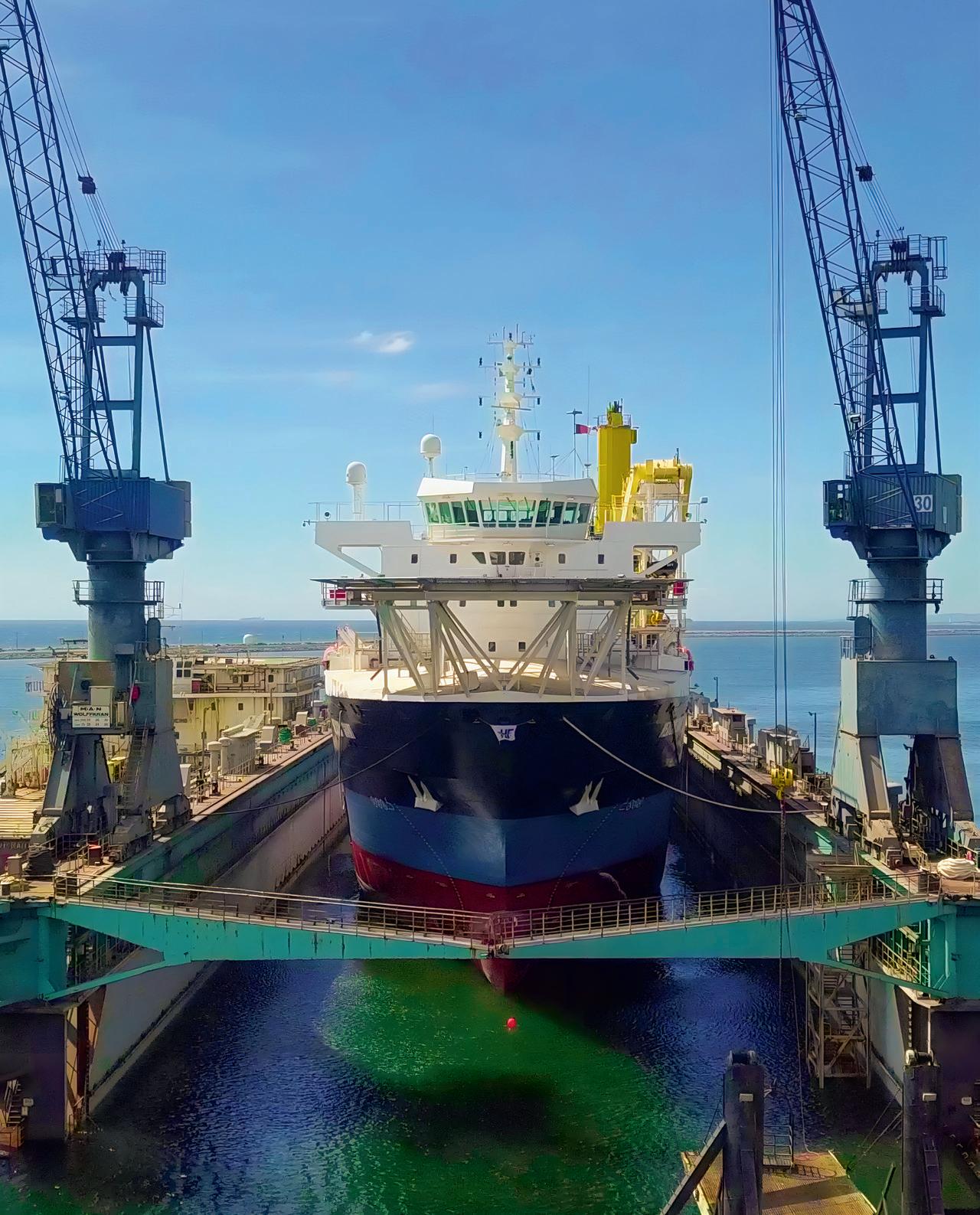 by Roland Malins-Smith
by Roland Malins-Smith
PORT OF THE YEAR AWARD I CSA'S AGM PHOTOS I MARTINIQUE ISSUE No 51
Colonel Martin
Rickman: from soldier to Shipyard CEO Reflections on 54 years in the Industry
Stick or twist Panama Canal

To promote and foster the highest quality service to the maritime industry through training development; working with all agencies, groups and other associations for the benefit and development of its members and the peoples of the Caribbean region.
SHIPPING ASSOCIATION COUNCIL 2023-2024
President: Marc Sampson
Immediate Past President: Juan Carlos Croston
Vice President: William Brown
Group A Chairman: Eduardo Pagán
Group A Representative: Nazilia Simone Phillips
Group A Representative: Rhett Chee Ping
Group A Representative: Desmond Sears
Group B Chairman: Mark Williams
Group B Representative: Cristyan Peralta
Group C Chairman: María del Mar Rodríguez
Group C Representative: Robert Bosman
Group D Chairman: JC Barona
Group D Representative: Sabine Bajazet
CSA General Manager: Milaika Capella Ras
CARIBBEAN SHIPPING ASSOCIATION
4 Fourth Avenue, Newport West
PO Box 1050, Kingston CSO, Jamaica
Tel: +876 923-3491
Fax: +876 757-1592
Email: csa@cwjamaica.com www.caribbeanshipping.org
ADVERTISING
advertising@caribbean-maritime.com
Tel: +44 (0)1206 752902
PUBLISHER
Land & Marine Publications Ltd
6 The Square, Ipswich, Suffolk
IP5 3SL, United Kingdom
Email: publishing@landmarine.com www.landmarine.com
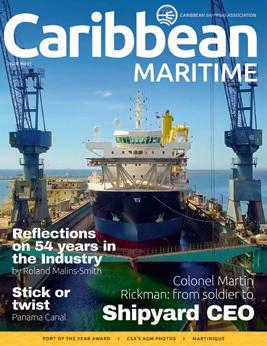



CONTENTS 3 FROM THE CSA PRESIDENT Propelling the Association to new heights 6 PROFILE: COLONEL MARTIN RICKMAN From soldier to shipyard CEO 13 ROLAND MALINS-SMITH Reflections on 54 years in the Industry 17 SUSTAINABILITY Caribbean Ports sustainability performance 22 MARTINIQUE Martinique backs sustainable maritime corridor project 23 PORT OF THE YEAR AWARD Barbados Port Inc clinches award 26 PANAMA CANAL Stick or twist for the Panama Canal 28 CSA'S AGM PHOTOS The 53rd Caribbean Shipping Association’s Annual General Meeting 33 ROUNDUP The latest news from around the Caribbean 39 ADVANTUM Sustainable Blue Economy CaribbeanMaritimeMagazine cm_magazine @caribbeanmaritimemagazine www.caribbean-maritime.com THE OFFICIAL JOURNAL OF THE MISSION STATEMENT
Views and opinions expressed by writers in this publication are their own and published purely for information and discussion and in the context of freedom of speech. They do not necessarily represent the views and opinions of the Caribbean Shipping Association – The Publisher. ©2024 Land & Marine Publications Ltd. Caribbean Maritime is delivered to subscribers in biodegradable packaging and the magazine is produced using paper from PEFC certified sources implementing sustainable forestry policies to help preserve our environment. ISSUE
6 13 23 1 www.caribbean-maritime.com Front cover image: Jordon Smith AlanMorris / Shutterstock.com
No 51

Propelling the Association to new heights

 Marc Sampson President Caribbean Shipping Association
Marc Sampson President Caribbean Shipping Association
In reflecting on the past year, I am optimistic and excited, knowing that our commitment to the values of community will propel this Association to new heights.
This dedication to excellence has been exemplified through various initiatives, most evident in the
training of over 200 individuals across different areas within our industry and the successful execution of two well-received and widely supported conferences, in 2023.
The training initiatives undertaken by the Caribbean Shipping Association (CSA) have not only empowered individuals but
3 www.caribbean-maritime.com FROM THE CSA PRESIDENT
FROM THE CSA PRESIDENT
have also strengthened the very fabric of our community. We are a stronger, more skilled workforce, ready to face the challenges that lie ahead.
As we navigate the ever-changing tides of global commerce, it is crucial to build on our successes and continue forging a path towards a brighter future. Our industry is ever-evolving, and it is in our hands to shape its trajectory.
CSEC Miami
Looking forward, the CSA is prepared to continue this vein of success in the in 2024. The upcoming Caribbean Shipping Executives’ Conference (CSEC) in Miami, scheduled for May 20-21, 2024, at the Hilton Miami Airport Blue Lagoon, will be a culmination of our collective achievements. It will be a platform where we not only celebrate our successes but also chart the future.
We will not only showcase the best practices and innovations that have defined our industry but also continue our mission to empower individuals. By fostering a culture of learning and growth, we ensure that our community remains resilient and adaptable to emerging challenges.
Community
Moreover, it will be an opportunity to network with like-minded professionals, creating business links that will further strengthen the bonds of our community. I extend a warm invitation to each one of you to join us in Miami, where we will continue to navigate the seas of opportunity, building on the successes of the past and creating a legacy for the years to come. The CSA is not just an organization; it is a community of individuals dedicated to the prosperity of our industry.
In the words of US cultural anthropologist Margaret Mead, "Never doubt that a small group of thoughtful, committed
I extend a warm invitation to each one of you to join us in Miami, where we will continue to navigate the seas of opportunity, building on the successes of the past and creating a legacy for the years to come ”

citizens can change the world; indeed, it's the only thing that ever has."
Our community, our Association, has the power to shape the future of the Caribbean shipping industry. Thank you, and I eagerly anticipate seeing you at CSEC 2024, where our collective journey continues.
4 Caribbean Maritime


From soldier to shipyard CEO
“I continue to change lives for the better”
PROFILE COLONEL MARTIN RICKMAN 6 Caribbean Maritime

It’s
a dilemma for many who have spent long years serving in the military: what to do with the rest of your life and how to put your training and experience to good use. For Jamaica’s Colonel Martin Rickman it has been a seamless but, perhaps, unusual transition from soldier to shipyard CEO.
Q. Where were you born?
A. In Kingston, Jamaica, in 1968. I was one of nine children for my parents.
Q. What influence did your parents have on your early life?
A. My father was a salesman for a dry goods company in Jamaica and my mother was a stay-at-home mom. My father was quite strict with us children and ensured that all got a good education. Daddy was tough, but my mother was the one we could always go to for support.
Q. Where did you go to school?
A. I attended Kingston Technical High School (KTHS) located in the heart of town. Being at a technical school, I found my love for engineering and construction subjects. It was at KTHS that I decided that I wanted to be in engineering.
Q. What was life like for you as a young person growing up in Jamaica?
A. As a young person with a large family, there was always a lot to do, fun times and adventures, but of course there were frequent fights and disputes over minor trivial things. At one point, eight of the nine children attended the same school, which included both, a preparatory school and a high school on the same compound. I had siblings who were almost in every grade level.
Q. What about college or university? In what subject(s) did you graduate?
A. I attended the College of Arts Science and Technology (now the University of Technology) where I studied Construction, Engineering and Management. I completed several high-level leadership and management training and studies while also a member in the Jamaica Defence Force (JDF). Later I attended the University of the West Indies where I completed
a Master of Science Degree in National Security and Strategic Studies.
Q. What was you first job on leaving full-time education or did you go directly into the military?
A. My first job after high school was as a draughtsman at a civil/structural engineering firm in Jamaica. Ironically, I had the honour to engage them about the engineering work for the shipyard we recently developed in Kingston, Jamaica.
Q. You joined the JDF in 1990 and did initial officer training at the Royal Military Academy Sandhurst (RMAS) in the United Kingdom. You were subsequently commissioned in the rank of Second Lieutenant in the JDF. What did you learn from your time at the Academy?
A. At the Academy we studied leadership and command while leading troops into operations. We were also exposed to strategic levels of international affairs and similar studies. The RMAS is a very prestigious military training institute in the United Kingdom and the Commonwealth and many high-profile figures including members of the royal family have attended. It was a one-year academic and physical training course that covered many training exercises in very harsh environments in extreme geographical and climate conditions. This experience represented a significant challenge for me and on completion it rewarded me with a great sense of pride about this accomplishment.
Q. In 2017 Prime Minister Andrew Holness chose you to be National Coordinator of the Housing, Opportunities, Production and Employment (HOPE) program. Prior to this appointment you had also worked with several social intervention programs during your service in the JDF including the Citizen’s Security and Justice Programme (CSJP). Is it fair to say that these roles seem, at face value, somewhat
7 www.caribbean-maritime.com

unusual for someone with long and distinguished military background?
A. Yes, it is fair to say that it is an unusual role to take on for a person with a background such as myself. On the other hand, my military training and experience were well suited to conduct such a program, which included project planning, coordination and training, particularly of unattached youth in Jamaica and my own background helped to prepare me for such a position.
Q. After 28 years in the JDF you were promoted to the rank of colonel in 2018. When you look back, are you proud of what you achieved during your time in the military?
A. I am proud of my years of service in the military to my country and to the wider
region. In total I served 32 years, which somehow did not seem that long. During my career, I was deployed locally as well as internationally. These deployments were mainly for humanitarian disaster relief missions such as to Montserrat in 1998 after the eruption of the Soufriére Hills Volcano. For this mission I planned and deployed a team of military engineers to assist in the rebuilding of homes for displaced persons affected by the pyroclastic flow from the volcano. I also led planning and coordination for the deployment of the Caricom delegation sent to Haiti after the devastating earthquake in 2010. I have been involved in several military operations over the years and I like to believe that I made a difference to so many lives because of my personal efforts.
Q. On leaving the armed forces, in what was a significant career change, you joined the German Ship Repair Jamaica (GSRJ) in March 2021. What attracted you to a position in a completely different sector and was your engineering background in the JDF a factor in your decision?
A. I was introduced to the company by a close friend who indicated that there were challenges being faced with the development of the shipyard. Being someone who always loved a good challenge, this became attractive to me as at the time I was thinking about what my plans would be after my military service.
I particularly liked the idea of helping to create an entirely new industry in Jamaica that would come with creating new employment and opportunities for the country and its citizens.

Q. Within a few months of joining GSRJ you were the yard’s CEO. How did this step-up happen so quickly?
A. I was recruited as CEO of the company when it only had an interim CEO present. Although all the research and the planning had been done before my joining GSRJ, the company could not get the shipyard started. I had to to review all the plans to implement and develop a shipyard, including assisting with securing the finances necessary to complete it.
Q. You joined GSRJ at a time when the company was planning a major expansion and you subsequently worked to successfully raise USD 37 million – much of this money from within Jamaica – to fund the purchase of the yard’s first floating dock, which arrived in Kingston last year. How difficult a task was it get this kind of financial backing locally? And what were the main challenges undertaking a project of this scale?
A. First of all, the original plans and designs for the shipyard were very extensive, with all the perfect bells and whistles included. The bank reviewing those plans had reservations and the entire
9 www.caribbean-maritime.com PROFILE COLONEL
RICKMAN
MARTIN
project seemed to be collapsing. I worked with my small team to develop a new, leaner project plan. I moved the project from a ‘Rolls-Royce’ of shipyards to being a ‘Toyota’ shipyard, with high efficiency and reliability which was far more achievable both financially and practically. I called up my friends at Sagicor Bank and made the pitch for the project support, at the end of the presentation I will never forget the VP for Investments at the bank leaned back in his chair and said: “This looks like a great new project for Jamaica. It is a no brainer and we would be happy and honoured to support”. Although it was a difficult task to convince potential investors that this was a worthwhile investment opportunity with excellent potential for growth of Jamaica’s economy, I thoroughly enjoyed doing just that. It helped that I absolutely believed in the project myself!
Q. What has been the yard’s experience over the last few months with the floating dock in place, employing an expanded workforce and the opportunity to bid for bigger and more complex repair contracts?
A. The experience has been extremely valuable faced with several challenges to be overcome as expected when developing a pioneering industry of such magnitude. This includes finding qualified local and international sub-contractors and talent to support the development and operation of the shipyard.
The floating dock now renamed as ‘JAM-DOCK 1’ is more than 40 years old, which also means a lot of maintenance and upgrading of the systems is required.

Q. How do you now see the yard’s position in the Caribbean ship repair market?
A. Due to our strategic geographical location, we are excellently positioned to serve the regional ship repair needs. This is a Panamax-size floating dock, and our proximity to the Panama Canal and as a hub for shipping activities in the region, we have a great vantage point to add to the existing facilities in the region to satisfy a huge market demand.
Q. Has heading up a growing shipyard been a challenge after a life spend mostly in the military and the charitable sector?
A. It has been a great challenge, yet a very rewarding one. I still keep myself involved in youth development programmes because that is another passion that I have – helping young people develop and find their paths. I believe that
I worked with my small team to develop a new, leaner project plan. I moved the project from a ‘RollsRoyce’ of shipyards to being a ‘Toyota’ shipyard, with high efficiency and reliability which was far more achievable both financially and practically”

10 Caribbean Maritime
PROFILE COLONEL MARTIN RICKMAN
Image: Fire Design Agency

more of us should contribute as much as we can to support development in the Jamaica we love!
Q. What has been your most memorable professional accomplishment to date?
A. It is difficult to single out some things because each has its rewards. One of the most significant accomplishments has been the missions to Montserrat and Haiti after the devastation they suffered. My team and I were able to significantly and positively impact so many lives.
I was also very proud of the impact made with the Prime Minister’s HOPE Program for unattached youth during my five-year reign. Over 30,000 young people received some form of training and work experience through my efforts. To this day, former participants will approach me on the street to say thanks for the start that I gave to them.
The development of Jamaica’s first shipyard will undoubtedly stand out as the most significant achievement of my life, although we are still working out the kinks of a new industry in the country. This one I am particularly proud of.
Q. Beyond work, what are your main interests and hobbies?
A. Creating opportunities for young people to find their way in life has been one of the main driving forces and interests of my personal and professional career. I continue to work with charities such as the Inter-American Development Banksponsored Jamaica Employment and Training (JET) project and chair steering committees of a privately funded Hope Opportunity Charity for youth, which gives me a great sense of satisfaction.
My other interests include hiking and exploring new places, cycling and cruising on my motorcycle on weekends.
Lastly, spending time with my family is always a source of rejuvenation and relaxation that provides me with the strength to master all the challenges.
11 www.caribbean-maritime.com

Reflections on 54 years in the Industry
and a note to the next generation
By Roland Malins-Smith LLD Hon.

The English philosopher John Stewart Mill is said to have described the West Indies as “the place where England finds it convenient to carry on the production of sugar, coffee, and a few other tropical commodities”. Our history as plantation economies records a high dependence on external trade, as all production inputs including labor were imported by ship, and all of the product was exported by ship.
The limited size of our states further reinforces this dependence on external trade and shipping. As Caribbean economist William Demas noted, for any degree of development attained, a small country is likely to possess a more specialized structure of production and a
correspondingly higher dependence on external trade than a large continental size economy.
Our historical experience and geography both dictate a strong dependence on maritime activity.
The question we must ask ourselves as Caribbean natives is whether we are sufficiently engaged in this maritime activity, whether a significant proportion of our young people find work at sea, how much do we participate in the various related fields of shipbuilding, drydocking, ship-repair, logistics, crewing, agency representation, IT, cyber security, port management, port state control, international regulation, maritime legal services, ship brokerage, ship operation,
and ultimately ship ownership. Our people migrate in droves in part because of high unemployment rates and a relative lack of local opportunity. This is a reminder that there is a world of shipping out there which is crying out for talent. BIMCO, the International Chamber of Shipping and maritime consultants Drewry have all warned of a severe shortage of seafarers and officers in the coming years.
Tradition
Puerto Rico, the Dominican Republic, Panama, Venezuela and Colombia have a tradition of naval training. Jamaica, Trinidad, Guyana and The Bahamas have all emphasized and provided maritime education opportunities for their young people
13 www.caribbean-maritime.com
REFLECTION ROLAND MALINS-SMITH
in recent years and are making progress in securing employment for their graduates on tankers, cruise ships and container ships. The governments of the Eastern Caribbean islands need to be made aware of these opportunities, encourage their high school students to take an interest in the maritime sphere, and support such tuition where it is available.
I would expect that more than 90% of the goods we consume, or export are carried by sea. Since maritime is obviously so critical to our economic well-being, the other question we should ask ourselves is whether the services available to us are adequate and cost-effective, and what should be our long-term strategy for participation.
Cargo liner services
My days of working with Caricom left me with the impression that the cargo liner services plying the Caribbean were expensive and fell short of our needs. My subsequent experience operating ships in the trade from Florida to the Caribbean has changed my views 180 degrees. One can argue that there are unmet inter-island shipping needs in the Eastern Caribbean, but there is little doubt that the network of extra-regional services provided to Caribbean ports from Europe, North America and the Far East is frequent, comprehensive and competitive. Weekly container connections exist on every

A modern ro-ro ferry service can move passengers, containers and cars among the ports to meet this perceived need. It could also help train our marine cadets”
sector. Rate agreements among carriers do exist, but their impact is only felt during times of vessel shortage, a global risk.
The number of carriers involved in the trade, the right of independent action of each carrier, the bargaining strength of cargo interests and the ubiquity of shipper contracts all make for a very competitive external trade, and competition keeps profit margins to a minimum. In my own experience, consistent profitability is a challenge for most if not all of these operators.
Recently we have heard of initiatives, both private and government, to promote a cargo/passenger ferry service in the eastern Caribbean and Guianas. This appears to be an important pursuit for a few reasons.
The international container ship operators and even the specialized feeder operators typically take inter-port business if it is consistent with their overall scheduling objectives, which objectives prioritize transit time to key southbound ports, frequency, and day of arrival. Empty containers need to be evacuated and returned to the home port, and the cost of doing so is happily offset if export business is available. Taking the container to a third and fourth port however involves an analysis of marginal cost and revenue and is often not worth the effort if overall service objectives could be compromised. Simply put, inter-port service on its own is not a priority.
Yet there is a real need to support regional trade, particularly in foodstuffs,
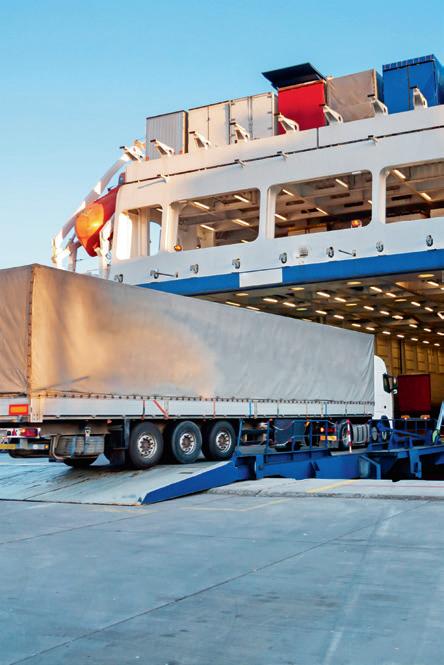
perishables and light consumer goods. This has always been a Caricom concern, and is attracting attention again at a time when inter-island air travel services are less frequent and rather more expensive. A modern ro-ro ferry service can move passengers, containers and cars among the ports to meet this perceived need. It could also help train our marine cadets.
There are however some ideas which should govern an approach to such services, and these suggestions are not altogether mine, no pride of ownership here.
Political
Government ownership and operation of shipping services is not recommended. We have gone this way before with West Indies Shipping Corporation (Wisco), with political decisions at regional and board level which make little commercial sense, and with unpaid subsidies. Shipping services must be run on a commercial basis, owned and operated by the private sector, geared to profit. Caribbean governments’ role would be to provide where needed suitable port infrastructure, and to publish regulations to facilitate the movement of cars, trucks
14 Caribbean Maritime REFLECTION ROLAND MALINS-SMITH Red Lemon / Shutterstock.com

and wheeled containers on the roads of each state to allow for movement of traffic after a reasonable time for formalities and inspection upon discharge. Importantly, Caricom members should adopt a common corporate tax holiday policy on shipping
investment by nationals of member countries to promote shipping investment as part of a long-term strategy to develop the shipping sector.
We also need to preserve and protect our environment. Our natural Caribbean beauty is worthy of preservation even without mentioning its tremendous commercial value. The world regards Caribbean tourism as our comparative advantage. Our region gave birth to cruise shipping and still control 38% of global activity. We need to be more pro-active in implementing the MARPOL Convention to discourage pollution of our waters and to legally hold and fine those responsible for incidents of pollution. We need to continue to strengthen our Port State Control bodies to police the ships which enter our waters to help hold polluters accountable. We need to remove wrecks which threaten navigation, many of which still contain fuel. In the absence of these mundane and unglamorous steps by our governments we remain exposed to a major marine disaster and pollution incident which can do painful damage to our tourism sector. We had one recently off Tobago.
And so, there is a need for young people,
enthusiastic and motivated people, to help us as maritime lawyers, as surveyors, as marine engineers, as salvors, as pilots, as captains, as entrepreneurs. We may even have innovators among us, as the industry searches for the next clean fuel.
Humble beginnings
Many of the captains of our global shipping industry had humble beginnings. Malcom McLean, the man credited with starting the container revolution, was a trucker who never went to college. Gianluigi Aponte, who founded MSC, was a ferry boat captain who bought a small breakbulk vessel with US$5,000 of his own money, now controls 645 ships, some of the largest in the world. I always remember the small picture of a 500-ton coaster vessel on the office wall of Ted Arison, the founder of Carnival Cruise. The caption below it read “Arison Bahamas Line”. I had the privilege of working for him. A positive, hugely successful and charming man, he was an inspiration to me. That picture was his reminder of his humble beginning in the shipping business.
A great journey begins with one step, and the courage to take it, always believing in your dream.



Caribbean Ports sustainability performance
Maritime transport is pivotal in international logistics chains and facilitates economic growth between regions and countries. Fuelled by globalization and containerisation, global seaborne trade volumes reached around 11 billion tons in 2021, with a growth rate of 4 per cent over the last five years. Shipping also accounts for over 80% of the world’s merchandise trade transport.
Even though maritime transport has
been regarded as an environmentally friendly mode of transport in terms of emissions per kilometre, given the share of maritime transport in total world trade, its impacts on the environment are not negligible. Furthermore, port authorities have extended their port infrastructure to satisfy the growing demand for maritime transport and logistics services and to accommodate the wide range of container vessel sizes. Thus, increased international
 Dr. Averne A. Pantin ESG Strategist
Dr. Averne A. Pantin ESG Strategist
seaborne trade and port expansion have led to significant adverse environmental effects, including increased noise, reduced air quality, biodiversity loss, water pollution, and public health and safety impacts.
With global regulations regarding environmental issues in maritime transport being developed and enacted, for example, the MARPOL regulations and the Kyoto Protocol, ports face more significant pressures to comply with regulatory and
17 www.caribbean-maritime.com SUSTAINABILITY

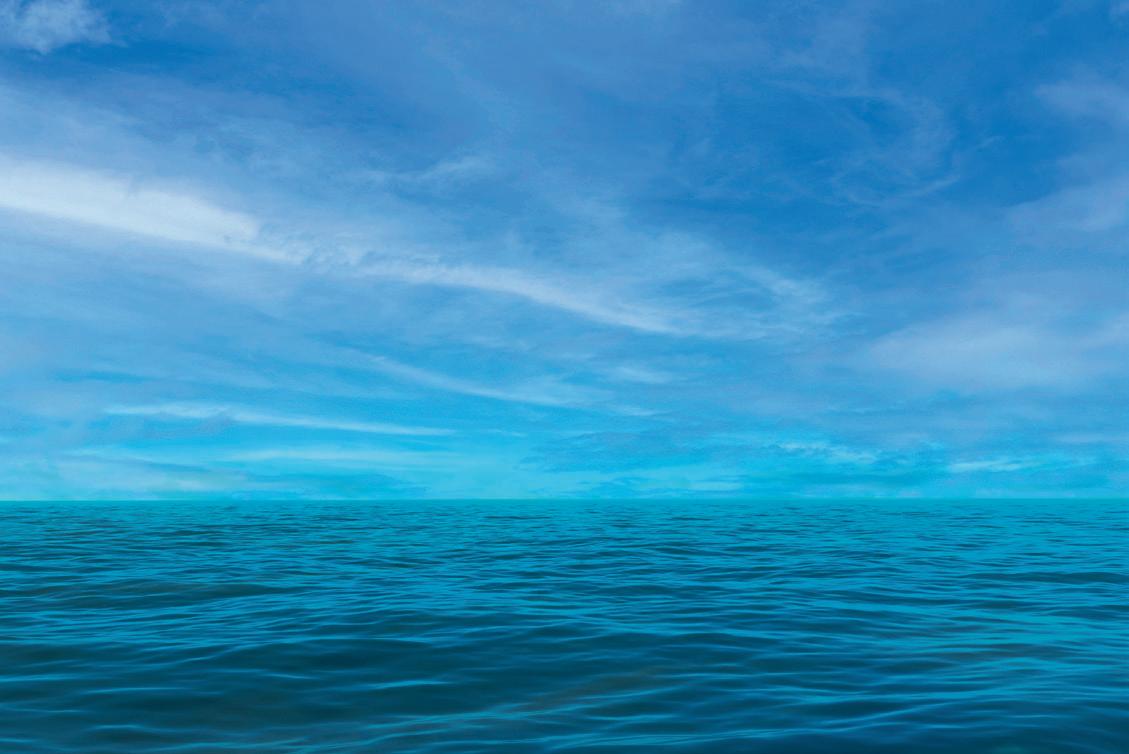

Caribbean Maritime magazine is published three times a year and is mailed throughout the region and beyond to subscribers in both hard and soft copy, has its own dedicated website, can be downloaded from the CSA website and is available across multiple social media platforms. Book your advertisement in the next issue now to reach Caribbean Maritime’s unique and highly influential readership.
CONTACT US advertising@caribbean-maritime.com or call +44 (0)1206 752902
CaribbeanMaritimeMagazine cm_magazine @caribbeanmaritimemagazine
www.caribbean-maritime.com
The official journal of the Caribbean Shipping Association
ADVERTISE IN
SUSTAINABILITY
societal requirements for operational sustainability. Ports have had to take progressive action in this area because it has become paramount when shipping companies determine which port to use.
Ports are inherently complex systems interlinked with numerous internal and external factors and broader port functions such as socio-economic issues. Indeed, each port establishes and implements different operational management strategies depending on geographical position, size, ownership, policy, administration, and stakeholder characteristics.
Support
A port operating at a high level of sustainability is more likely to attract support from the government, communities, the public, and potential investors in the maritime industry. Ports have thus increasingly had to make costly investments to achieve regulatory compliance and improve their Corporate Social Responsibility image. But many port operators will ultimately aim to increase profits and only invest where necessary. In contrast, sustainable port development strategies potentially require heavy financial investment; it is still unclear if the concept of port sustainability is successful or has yielded positive outcomes.
As incompatibility between sustainable management and economic advantage continues to emerge in ports and related activities, previous data on sustainability performance in ports has reflected an understanding of global sustainable development issues in the context of ports, for example, incorporating sustainability challenges into operational practices and strategies and increasing sustainability performance capability from a management perspective.
Data has also delivered insights into practices and operations regarding port sustainability performance, which have mainly been addressed from three perspectives: performance measurement, performance management, and the relationship between the three aspects of sustainability examining the effects of environmental or social management on economic
… sustainable port development strategies potentially require heavy financial investment; it is still unclear if the concept of port sustainability is successful or has yielded positive outcomes.”

performance in the context of ports.
Port sustainability is rooted in the three pillars of sustainable development that embrace environmental, social, and economic goals. Its primary purpose is to seek a safe, socially acceptable, energyefficient, and environmentally friendly port management approach while maximising profits. Practical and multidisciplinary management techniques are required to integrate the socio-economic, legal, technical, and environmental practices and to analyse the performance of sustainable responsibilities with appropriate data on components of sustainability.
Assessments
Overall, quantitative assessments of port sustainability performance are seen in the study of financial measures such as operational efficiency, container throughput, costs, and economic impact on measures such as Gross Domestic Product. Given that many ports operate as public/private enterprises, performance assessment using a quantitative approach is reasonable for
understanding the relationship between profits and costs. Additionally, decisionmakers must use scientific evidence through quantifying actions to validate the substantial investment required to implement and track progress towards port sustainability.
The conflicting aims between the economic and environmental dimensions –cost-efficiency in port operations and additional investment for managing environmental impacts – seem to contribute to the considerable utilisation of various research methods. Mainly, the most preferred technique by researchers is to reveal the best and most optimum practices for practical, sustainable operations. However, there are difficulties in measuring the performance of port sustainability. For example, the individual nature of each port in terms of its resources and unique operating environments has made the consistent assessment of port sustainability performance elusive. In this respect, efforts have been made to reflect geographical similarities in measuring green performance through case
19 www.caribbean-maritime.com














View all back issues of Caribbean Maritime magazine on mobile, tablet and desktop qrs.ly/mdbz822
SUSTAINABILITY
studies, focusing on ascertaining differences in the eco-friendly levels between ports in a similar geographic area.
Furthermore, it has been shown that indicators should be established for the assessment of port sustainability performance in order to understand the structure for the implementation and evaluation of green port management. This review identified various environmental, social, and economic indicators of green port issues.
Typical indicators for assessing port sustainability from an environmental perspective are related to water management, air pollution management, energy and resource use, and noise control.
Regarding the social aspects, health and safety are essential, while for economic aspects, Foreign Direct Investment and efficient port operations are primary issues.
From an environmental perspective, it can be seen that there is a slight difference between indicators used by researchers for assessment and those appreciated as important and prioritized by practitioners such as port authorities, port managers, and port operators.
The most frequently mentioned indicators in the reviewed studies for assessing port sustainability are associated with water pollution management. However, atmospheric pollution management and
energy consumption are regarded as more essential indicators than water quality when making decisions on the successful environmental performance of ports.
From an operational perspective, energy usage within a port area, including fuel consumption, is high but unavoidable for ongoing port operations. As practitioners have recognised and underlined the importance of overall port operations and management efficiency, efficient energy management is assumed to be the most salient factor for practitioners, enabling them to comply with environmental requirements while achieving economic growth.
Opinions
The analysis of this reviewed study shows that few reflect the opinions of local groups regarding port sustainability. This implies that even though most reviewed studies have verified that public relations have been positively associated with port economic performance, the weak power of local stakeholders in green port planning and management has still been detected as a barrier against the achievement of port sustainability.
External cooperation with green activities is underlined by the several studies reviewed as one of the mediums for

efficient port operations since port systems are engaged in various functions and relations, for example, green road systems linking the port to its hinterland and green actions of shipping companies.
Public participation also plays a vital role in embodying a specific sustainability scheme of ports, for example, the engagement of local governments, which are responsible for enacting legislation to promote eco-friendly industries located near the port, allowing them to comprehensively control air and water quality in surrounding port areas. Thus, to fulfil the successful implementation of port sustainability, communities, groups, and organisations affected by port activities should be considered in the decision-making process of port sustainability operations.
Implementation
Furthermore, integrated performance measures are required to support port sustainability's practical and balanced implementation with consistent and meaningful evaluation evidence over time. However, establishing an integrated evaluation standard is another conundrum in measuring port sustainability performance. Ports are complex organisations affected by the economy, culture, policies, local communities, geographical locations, and administrations, taking their positions about port sustainability operations and management. Indeed, depending on the size and type of port, organisational structure, and location, the level of environmental impact from port activities may vary from port to port. Hence, the criteria for performance evaluation may not be consistent among ports.
The issue of sustainable development for ports is not limited to one country, nor is it easy to conduct an integrated evaluation of sustainability performance for ports due to the distinct nature of port administrations. Therefore, a model or tool that can reflect the international evaluation criteria and each port's characteristics should be developed to overcome the challenge of conflicting claims.
21 www.caribbean-maritime.com
Martinique backs sustainable maritime corridor project

Via the Hub Éco France-Antilles project, Grand Port Maritime de la Martinique (GPMLM) is taking significant steps to establish a sustainable maritime corridor between Europe and the Caribbean.
This collaboration reinforces the vision shared by the regional authorities in the Caribbean, French carrier CMA CGM and GPMLM for a major ecological transformation of container handling and transshipment operations in Martinique.
GPMLM is committed to the construction of a new Caribbean Hub, positioning Martinique as a key entry point to a sustainable maritime corridor between the Caribbean and Europe. This lowcarbon container terminal, equipped with a Smart Grid, aims to halve CO² emissions. These new facilities will make it possible to manage large vessels while
doubling the terminal's activity and ensuring enhanced safety.
GPMLM is preparing for this new chapter by launching two major projects:
First project
The first, supported by France Relance –the €100 billion government investment plan aimed to make the France Europe’s first major decarbonized economy – and the Territorial Collectivity of Martinique, consists of a photovoltaic installation with storage, using state-of-the-art technologies to reduce the carbon footprint of transporting goods in containers.
Second project
The second project, valued at €120 million, includes the crucial extension of the port terminal to meet IMO2023 standards. These investments are in addition to those
planned for new vessels by CMA CGM. They are essential for the expansion of the terminal, the acquisition of equipment and the adjustments required to support current and future marine traffic.
This eco-transformation represents a new era for GPMLM’s Pointe des Grives Container Terminal. By introducing new technologies and structures to the terminal, GPMLM is initiating a major change. These advancements completely redefine the way the port operates, with a focus on efficiency, sustainability, and adherence to strict environmental standards.
This remodeling goes far beyond a simple physical transformation. It means a transition to a new era for the terminal, propelling it to high levels of operational performance, efficiency and environmental friendliness.
22 Caribbean Maritime
MARTINIQUE
/ Shutterstock.com
byvalet
Barbados Port Inc clinches Port of the Year Award

At a glittering ceremony at the Gala Dinner during last year’s Caribbean Shipping Association’s 53rd Annual General Meeting, Conference, and Exhibition, Barbados Port Inc was announced the winner of the coveted Ludlow Stewart Container Port of the Year 2023 award.
The elegant Gala, hosted by the Shipping Association of Trinidad and Tobago at the Hyatt Regency hotel in Port of Spain, was attended by leading figures from the
Caribbean shipping and port industry.
The event served not only as a platform for recognizing the outstanding performance of Caribbean ports but also as a means of giving back to the community. During the evening an impressive US$76,000 was raised to support the Frank Wellnitz Training Program, a vital initiative aimed at enhancing the skills and knowledge of future maritime professionals. The event also saw the participation of Delroy Matherson, a cadet at the Caribbean
Maritime University, and the most recent recipient of the CSA’s prestigious Monica Silvera Scholarship.
The evening followed two days of informative conference panels that addressed crucial industry topics, including decarbonization, navigating supply chain challenges, sustainability, artificial intelligence, and cruise shipping. These discussions provided a platform for industry leaders to share insights, exchange ideas, and chart the course for the future of the
23 www.caribbean-maritime.com PORT OF THE YEAR AWARD

Multi-platform publishing and design services
Tel: +44 (0)1206 752902 Email: publishing@landmarine.com www.landmarine.com


cm_magazine @caribbeanmaritimemagazine www.caribbean-maritime.com

CAPTIVATING
INSPIRING
INFORMATIVE
CaribbeanMaritimeMagazine
FOLLOW US ONLINE
Caribbean shipping and port sector.
The highlight of the evening was undoubtedly the announcement of the Ludlow Stewart Container Port of the Year award. This recognition signifies the exceptional commitment and dedication of Barbados Port Inc to providing stellar services and maintaining high industry standards.
According to the Port Award Chairman, Roland Malins-Smith, all entrants demonstrated outstanding performance in the category of industrial relations. Encouragingly, around 60% of the participating ports recorded a remarkable reduction or, in some cases, no accidents at all. This exceptional safety record reflects the commitment of Caribbean ports in maintaining a safe and reliable work environment.
Notably, most ports increased their investments in security, compared to the previous year, underlining their commitment to safeguarding assets and ensuring the well-being of all stakeholders.
In the category of environmental sustainability, seven ports earned full marks, with Martinique, Guadeloupe, and Barbados all leading the way in environmental protection and conservation. These ports have set an inspiring example for the industry by implementing sustainable practices that minimize their environmental footprint.
Furthermore, Malins-Smith highlighted the impressive strides made in promoting gender diversity within the industry. Nine ports increased their proportional employment of women which is a promising sign of progress toward creating a more inclusive and diverse maritime workforce.
The top five ports all scored within a 10-point margin of each other, showcasing the remarkable standard of the regional maritime sector.
In addition to Barbados Port Inc’s victory, there was a tie for second place, shared by the Port of Cartagena Group and the previous year’s winner, Havenbeheer Suriname. Rounding out the top five were Grand Port Maritime de la Guadeloupe and Hutchinson Ports FCP in Freeport, The Bahamas.

The top five ports all scored within a 10-point margin of each other, showcasing the remarkable standard of the regional maritime sector.”




25 www.caribbean-maritime.com
PORT OF THE YEAR AWARD
Port of Cartagena
Grand Port Maritime de la Guadeloupe
Havenbeheer Suriname
AlanMorris / Shutterstock.com chromoprisme / Shutterstock.com Andy A Graham / Shutterstock.com
Hutchinson Ports FCP, Freeport
Stick or twist for the Panama Canal
Decreased rainfall is restricting passage through the Panama Canal. With no quick fix for climate change, Caribbean Maritime look at the options available to ensure year-round maximum capacity for the waterway.
We have experienced three strong El Niños in the last 25 years – 1997-8, 2014-16 and 2023-24 – and in each case they have badly disrupted weather patterns around the world.
This latest El Niño – which has been present since June last year – has a major impact on Panama resulting in much lower-than-expected rainfall over a relatively prolonged period.
As has been well documented (including in this magazine), the local water shortage has meant tough restrictions for Panama Canal transits – both in terms of daily slot numbers and in the permissible draft of vessels using the waterway – in the second half of 2023 and early 2024.
Shortages
But blame for the recent lack of rainfall has not just been laid at El Niño’s door. Some claim that water shortages are the direct result of climate change. A phenomenon that’s here to stay. While Panama’s 2023 rainfall total was indeed 30% below average, it was only the third driest year since 1950, surpassed by drier years in 1997 and 2015. Not exactly unprecedented.
Low rainfall – whether it be caused by El Niño alone or as a much wider climatic issue – still presents a big and potentially expensive question for the Panama
Canal Authority (ACP). So even if rainfall returns to normal this year –Panama City, for example, can expect receive around 1,900 mm of rain annually – it would be prudent to create additional water storage capacity. This would not only ensure year-round maximum capacity for the waterway, but also to meet growing demand for freshwater.
As Alexei Oduber, managing director of transit specialists GAC Panama explains: “Until we find a way to store rainfall to use during the dry months, the problem will continue to be an issue.”
In essence, the ACP still needs to do two things: reduce its per-transit water usage and increase rainfall storage. The proposed Rio Indio reservoir in Coclé province to the west of the canal have been around for some time and seems to be the answer to the latter and, if built, would provide the waterway with enough freshwater for the following 50 years. The reservoir will feed water into the Gatún Lake. A government decision on the project is unlikely to happen before May 5, when 'presidential elections are being held in Panama.
In any case and with the announcement in March that the ACP would be upping the number of daily transits, there are already a few encouraging signs that the situation is easing. “It is a clear indication that water conservation measures are working and that the outlook for a
medium-term solution with rainfall is expected,” says Oduber.
Further good news came in April when ACP announced that booking slots in the Panamax locks were set to increase from 16 May. And from 1 June, an additional slot is being made available in the Neopanamax locks.
Then there’s also a school of thought that global trade is too dependent on a single trans-isthmus canal, apparently subject to capriciousness of nature and that alternatives need to be explored or existing options improved. So, maybe a part solution to some of the present difficulties being experienced by the Panama Canal can be found beyond the waterway itself.
Options
For some trades this will be easier than for others. Containers are one key area where there are already some, mostly suboptimal, options. The most obvious and probably easiest solution (or part solution) is to improve and increase the capacity of the 75-km, mostly single track, Panama Canal Railway. The shorthaul land-bridge connection handles around 500,000 container moves per annum but there are plans to quadruple this figure with the number of trains per day growing from 10 to 32. Despite the additional costs, it has proved particularly popular in recent months with a number
26 Caribbean Maritime
PANAMA CANAL

of major carriers which appreciate the flexibility the railroad offers.
But let’s not forget plans first tabled back in 2013 to construct a multi-billiondollar trans-Nicaragua canal. A highly detailed and convincing presentation of the canal was even made to a somewhat skeptical audience at a previous Caribbean Shipping Association AGM.
Backed by Chinese investors led by Wang Jing, this now defunct megaproject seemed beyond possible at the time; although its supporters thought the idea had great merit. The scheme hit the buffers when the Chinese investors melted away as a vociferous environmental lobby and angry local farmers both took a dim view of the project.
The Nicaragua canal would, like the Panama version, comprise two
canals – one from the Pacific and one the Atlantic – connecting to Lake Nicaragua.
The Nicaragua National Assembly even approved the project and offered a 50-year concession to the investors –the HK Nicaragua Canal Development Investment Group. This company finally closed its door in 2018 without a shovel of earth being moved.
Can such a widely ambitious and costly alternative trans-Isthmus scheme ever be revised? It seems unlikely, but Ferdinand de Lesseps probably thought much the same in 1889 when, due to the bankruptcy of his company, he abandoned his efforts to build a sea-level Panama Canal only for the US to successfully take on the project some 15 years later.
The impact
The impact of the water shortage is apparent from the latest figures from ACP. The Panama Canal only saw 511.1 million Panama Canal/Universal Measurement System (PC/UMS) tonnes transit during Fiscal Year 2023 (October 1, 2022-September 30, 2023), compared to 518.5 million PC/ UMS tonnes moved in FY2022.
Nevertheless, ACP forecasts better revenues for Fiscal Year 2024. The new toll system introduced at the start of last year has helped boost income and gone part way to offset the reduced income (up to US$100 million a month) due to the transit and draft restrictions.
27 www.caribbean-maritime.com

The 53rd Caribbean Shipping Association’s Annual General Meeting
AGM 2023 highlights
The 53rd Caribbean Shipping Association’s (CSA) well-attended Annual General Meeting, Conference & Exhibition was held in Port of Spain, Trinidad 23-24 October, 2023.
Going against tradition, the CSA opted to condense the 53rd AGM into two actionpacked days with the popular Gala Evening
and Port of the Year Award ceremony taking place in the evening of the second day.
Monday’s Cultural Night saw the Shipping Association of Trinidad & Tobago put on spectacular of soca and steelpan show featuring the legendary Colin Lucas – a singer with strong shipping roots – along with other top local stars such Phase II.


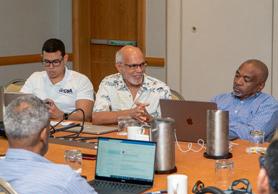
28 Caribbean Maritime CSA AGM 2023


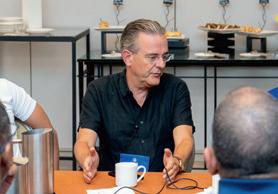



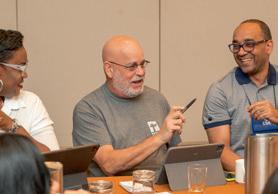





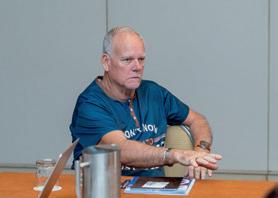






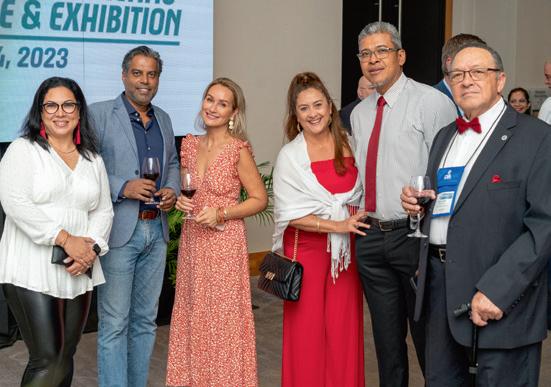
29 www.caribbean-maritime.com




















30 Caribbean Maritime CSA AGM 2023






















31 www.caribbean-maritime.com
















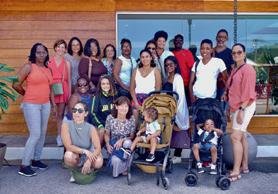




32 Caribbean Maritime CSA AGM 2023
News from around the Caribbean

Dom Republic
P&O Dominica is now handling tug operations at the Port of Caucedo.



Caribbean Maritime
roundup
Haiti
Hats off to privately operated Terminal Varreux in Port-au-Prince, which despite being located close to Cite de Soleil, a neighbourhood which experiences frequent gang-related violence, has kept its port facility open to international shipping and coastal vessels during the period of civil unrest. The terminal is receiving basic food necessities and a variety cargo such as: food commodities, petrochemicals and gas, construction materials and containers.
Richard Lebrun, managing director at Terminal Varreux says he is dedicated to keeping the flow of goods open and is thankful that the local authorities are securing nearby access roads.
The Bahamas
Nassau Cruise Port witnessed an unprecedented seven ships with over 20,000 passengers on board calling at the port on 12 March. The seven ships comprised Carnival Liberty, Vision of the Seas, Disney Wish, Independence of the Seas, Sea Cloud Spirit, Carnival Paradise, and Carnival Elation.
The record-breaking day follows the official opening of the newly redeveloped Nassau Cruise Port in May 26 last year. Under the management of Global Port Holding, the upgraded port now has six improved berths capable of accommodating mega-yachts and the largest cruise ships in the world, including Oasis-class and Icon-class vessels.


IMO
The delegation of the Caribbean group’s meeting in London with new IMO Secretary-General Arsenio Dominguez helped highlight the region’s commitment to championing Caribbean perspectives in the maritime industry. This group
Trinidad and Tobago
The Shipping Association of Trinidad and Tobago (SATT) has a new general manager. Michelle Mulcare took over in February and brings her experience in brand revitalisation and a practical take on improving strategic branding capabilities to the role. Ms Mulcare comes with a wealth of experience having previously worked for the Trinidad Building and Loans Association and Government Human Resources Services. SATT hopes her arrival will ensure the company continues to be at the top of organisations within the sector.

consisted of delegates from Belize, Grenada, Jamaica, Antigua a d Barbuda, Suriname, Barbados, St Kitts and Nevis, St Vincent and Grenadines, Trinidad and Tobago, as well as Dominica.
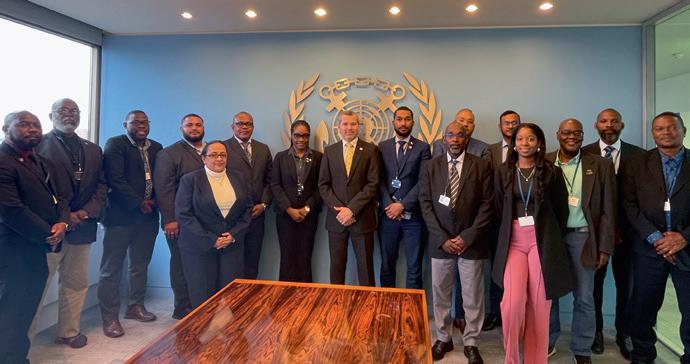
33 www.caribbean-maritime.com

Trinidad and Tobago
The Director of Ocean and Climate Change, UN Foundations Kerrlene Wills, met with UTT's Maritime Studies, MTCC Caribbean, CARIBMEPA, the Shipping Association of Trinidad and Tobago and the Trinidad and Tobago Pilots' Association. During the meeting, the urgency of regional representation in climate action negotiations within the maritime sector was discussed.
Opportunities for collaboration emerged, underscoring the Caribbean’s distinctive challenges and opportunities in decarbonising the sector. The meeting was held at the SATT office in Port of Spain.


Guyane

Geest Line
Puerto Rico
Global Ports Holding has begun operations in San Juan Cruise Port, Puerto Rico. A multi-million-dollar financing deal has given San Juan Cruise Port cruise port operations with immediate effect and paves the way for much-needed repairs, reconstruction and upgrades.

The wind-assisted Canopée on a recent call at Pariacabo with parts for the Ariane rocket launch site.
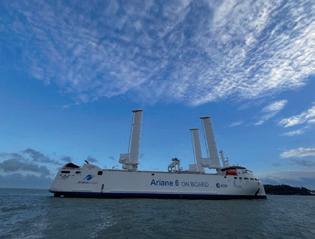

United States
Virgin Islands
The Virgin Islands Port Authority and Tropical Shipping have officially signed agreements to rehabilitate and expand the 20-acre Crown Bay Cargo Port in St Thomas and the 45-acre Wilfred ‘Bomba’ Allick Port and Transshipment Center in Krause Lagoon, St Croix. VIPA Executive Director Carlton Dowe and Tropical Shipping President Timothy P. Martin executed long-term lease agreements in January at a meeting held at Tropical’s headquarters in Riviera Beach, Florida.
SEACOR
Florida-headquartered King Ocean Services has acquired SEACOR Island Lines, a fellow Florida-based carrier with Ro/Ro and lift-on/ lift-off services to various islands in Turks and Caicos and The Bahamas. SEACOR Island Lines operates a fleet of eight Panama-registered vessels – six landing craft and two general cargo vessels.


Capt Peter Dixon retired as managing director in April after 29 years of service – 14 of them as MD – with Geest Line. He is replaced by Rob Waterman.
At the same time, Geest Line has unveiled its ‘Banana Container’. The brand-new reefer container has been painted yellow to stand out in the crowd, making it easier to track as it moves between the Caribbean, UK and Europe. The container will take temperaturecontrolled produce out to the Caribbean before returning to Europe loaded with bananas. If you see the container (there is only one), take a photo and tag #bananabox


Jamaica
Kingston Wharves (KWL) has commissioned its redeveloped Berth 7. The berth redevelopment project represents an investment of US$ 30 million and is a key part of the US$ 60 million the company has earmarked since upgrading of its facilities in Kingston began in 2020.
Over 182.5 metres of berth were reconstructed, dredged and extended seaward allowing KWL to handle larger vessels.
The work was undertaken by US firms Brayman FSI Construction and Shoreline Foundation.
News from around the Caribbean roundup Caribbean Maritime
34 Caribbean Maritime
Canopée
Colombia

Marking the first bulk grain operation at Sociedad Portuaria Mardique – a privately owned multi-purpose facility – the Liberian flagged Bulk Bequia arrived with over 59,000 tonnes, unloading close to 16,000 tonnes at the terminal to lighten the vessel before entering the port of Barranquilla.
Over 65% of the vessel’s cargo was unloaded as a direct operation, with more than 300 trucks attended in just over 48 hours.
Trinidad and Tobago
Boskalis-operated semi-submersible heavy-lift vessel White Marlin has been deployed in Trinidad as a makeshift floating dry dock.
By submerging the vessel, Boskalis enabled three of the four fast ferries – APT James, Buccoo Reef and T&T Spirit – of Trinidad and Tobago Inter-Island Transportation Co – to be loaded in succession onto the deck of the White Marlin, after which the vessel de-ballasted so that the necessary maintenance on the ferries could be carried out on a dry deck.
This is not the first time Boskalis has used one of its semi-submersible heavy transport vessel for this purpose in the region. Previously, the BOKA Vanguard served as a floating dry dock in The Bahamas for the 67,000-ton cruise ship Carnival Vista.
 Marlin
Marlin
Florida
The Port of Palm Beach is among several Florida seaports experiencing milestones in ship calls as well as record revenue.
For the first time in more than a decade, all berths at the Port of Palm Beach were occupied with container ships, cargo ships, a cruise ship, barges and yachts berthed on February 1.


“This achievement is unheard of in my 22-year tenure as a Port Commissioner,” Port of Palm Beach Board of Commission Chairman Wayne Richards said. “Internal figures from Fiscal Year 2023 reveal we saw an 11 percent increase in net operating revenue, coupled with a seven percent reduction in operating expenses, resulting in a US$4.8M total net income. That is a $3.3M increase from the FY 2023 budget.”
Jamaica
Kalmar, part of Cargotec, has concluded an agreement to supply Kingston Freeport Terminal Limited (KFTL) with 12 Kalmar hybrid straddle carriers. Delivery of all equipment will be completed during Q2 2024.
KFTL is a strategic transshipment hub in the Caribbean and part of Terminal Link, a joint venture between CMA CGM and China Merchants Port (CMP). The 12 Kalmar hybrid straddle carriers are part of a progressive fleet geared towards improving performance, reliability and sustainability at the terminal. In addition to Kalmar straddle carriers, KFTL’s equipment fleet includes Kalmar reachstackers, empty container handlers and terminal tractors.
Richards credits the additional revenue to operational changes related to the cruise industry and strategic improvements in the cargo areas.



Trinidad And Tobago
La Brea Industrial Development Co (LABIDCO) welcomed the UK’s ASCO Group as its newest shorebased operator at the Port of Brighton.
ASCO, which had previously used the Port of Brighton as a base for its operations, will provide onshore support and logistics services for a major upstream company in Trinidad and Tobago.

35 www.caribbean-maritime.com
Wayne Richards
White

Guyana
Jumbo Offshore Installation
Contractors BV has been awarded a contract by MODEC Guyana Inc for the pre-installation of the mooring spread of the FPSO Errea Wittu, which will be located offshore Guyana.
The FPSO Errea Wittu will have the capacity to store two million barrels of oil. It will produce approximately 250,000 barrels of oil per day and will have gas treatment capacity of 540 million cubic feet per day and water injection capacity of 350,000 barrels per day.
MODEC Group was authorised to proceed with the engineering, procurement, construction and installation (EPCI) scope for the FPSO in May 2023, following a final investment decision on the Uaru project by ExxonMobil Guyana Limited and its co-venturers.



Jamaica
Rear Admiral (Ret’d) Peter Brady has retired (that’s two retirements) from the Maritime Authority of Jamaica (MAJ), having served as its director general since the Authority’s launch in 1999.
As director general, Rear Admiral Brady was largely responsible for elevating Jamaica’s maritime status regionally and globally.
Bertrand Smith has been appointed as the new director general.
Crowley
Crowley and Carbon Ridge Inc, a leading developer of modular onboard carbon capture and storage solutions (OCCS), have initiated an advanced pilot project to reduce emissions impacts using its Storm international container ship.
Working with support from the US Maritime Administration (MARAD) Maritime Environmental and Technical Assistance (META) program, The companies will make use of Carbon Ridge’s patent-pending, second generation carbon capture technology.Alog with MARAD, they have executed a cooperative agreement for the pilot program to operate, measure and optimize the technology’s effectiveness in actual maritime environments at port and ultimately at sea. The collaboration includes the engineering, manufacturing and integration of a small capacity version of Carbon Ridge’s full-scale carbon capture system.
“The advancement of the pilot project represents a milestone in
Florida
Port Everglades has taken delivery of three 53-meter-high Super Post-Panamax container gantry cranes. Valued at US$15.1 million each, each crane can handle containers stacked eight high from a ship’s deck and reach 22 containers across the deck.

Port Everglades
the emerging technology for carbon capture. With its potential for significant emissions reductions through retrofitting or during new building, ship owners and operators have the opportunity to future-proof their vessels for incoming regulations, as well as reach internal goals for decarbonization and reduced emissions impacts,” said Carbon Ridge CEO Chase Dwyer.
Crowley’s engineering services group is leading the integration of the pilot system on the Storm, which serves the US and Caribbean Basin. The carbon capture system will be housed in two 40-foot container units on the vessel’s main deck and have an additional 20-foot ISO-certified tank for storing the captured liquid CO2. The pilot project is expected to capture 1 metric ton per day from the vessel’s main engine.
Installation of the pilot unit on the vessel is expected in 2024 after onshore testing is completed.


Antigua and Barbuda
The WiMAC Antigua and Barbuda Chapter has been launched with former WiMAC president Tamara Lowe-James in attendance. Chapter president is Shenica Sebastien from the Department Marine Services and Merchant Shipping (ADOMS).

36 Caribbean Maritime
News from around the Caribbean roundup Caribbean Maritime

Guyana
Blue Water Shipping managed and executed the arrival of Vreed-enHoop Shorebase's (VEHSI) first commercial vessel, the bulkcarrier Virtuous Striker. It is the largest cargo ship to dock in the Demerara River.
Richard DeNobrega, Vice President Sales and Development at Blue Shipping said: “We are extremely happy to be part of this momentous occasion. VEHSI has and will continue to transform Guyana’s port infrastructure by increasing and improving its capacity to handle much larger vessels and cargo volumes. Providing expertise in a solutions driven environment enables the clients we serve to perform superbly and underscores our commitment to operations excellence.”


Guyane
Grand Port Maritime Guyane is taking a major step towards modernising the Oversea Department’s main commercial port with the installation of quay cranes built by the Franco-Chinese consortium Automatismes Etudes Services/Dinson (AES).
After a period of testing and the training of the crane drivers –employees of the Groupement des entreprises manutentionnaires de Guiana (GEMAG) – the two rail-mounted cranes will be gradually put into operation from June 2024.
An investment of €14 million, including €7.15 million from the European

The Bahamas
French foundation and soil technologies firm Soletanche Bachy International – in a joint venture with Soletanche-Bachy Colombia and The Bahamas’ Island Site Development – has been selected by Carnival Corporation to construct the new piers for Celebration Key.
Xpress Feeders
X-Press Feeders has brought back the Panama Venezuela X-Press (PVX) service with a refreshed rotation. The new bi-weekly PVX will significantly improve coverage in the region by extending the feeder operator’s services to La Guaira and Puerto Cabello.
The service rotation will be Manzanillo, Cartagena, La Guaira, Puerto Cabello, Manzanillo.
Regional Development Fund (ERDF) and €7 million (50% ERDF and 50% State) for the construction of the running tracks and the installation of the rails.


Celebration Key, a private destination on Grand Bahama, will open in summer 2025. Designed to receive two Carnival Cruise Lines Excel-class ships simultaneously, the piers will take around a year to be completed.
Jamaica
Bertrand ‘Bert’ Smith has been appointed the director general of the Maritime Authority of Jamaica (MAJ). He took up his new position at the start of April.
This is an in-house appointment. Smith previously served as director,
The joint venture will mobilize important Bahamian and international resources to carry out the construction and will use equipment and construction techniques designed to minimize the environmental impact during and after construction.
Carnival has since announced a doubling of its plans for Celebration Key, adding another US$100 million in investment. By 2026, expansions will mean four of Carnival's Excel-class vessels can berth at Celebration Key.

legal affairs and a member of the Authority’s senior executive team with over 25 years of experience in the shipping industry with expertise in maritime and international law.
37 www.caribbean-maritime.com
Grand Port Maritime Guyane
The Bahamas
Norwegian Cruise Line Holdings (NCLH) (comprising Norwegian Cruise Line, Oceania Cruises and Regent Seven Seas Cruises) is to construct a new, multi-berth pier at its Great Stirrup Cay private island resort. The development is scheduled to break ground mid 2024 and to be completed by late 2025 – an investment of approximately US150 million. The new pier will be able to accommodate two large NCLH cruiseships. NCLH has owned Great Stirrup Cay since buying the 268-acre island in 1977.



Florida
The Broward County Commission has approved the appointment of Glenn A. Wiltshire as Acting Director of Broward County's Port Everglades Department. Wiltshire, the previous Deputy Port Director, took over in February following the departure of CEO and Port Director Jonathan Daniels (see CM issue 48) to become Executive Director of Maryland Port Administration and the Port of Baltimore.


Trinidad and Tobago
The Port Authority of Trinidad and Tobago (PATT) has commissioned of the Konecranes SMV 37-1200C ready for operation. The forklift is the latest of in a series of equipment deliveries from Konecranes to PATT.



News from around the Caribbean roundup Caribbean Maritime
EWY Media / Shutterstock.com
Jonathan Daniels
Leveraging technology for a sustainable blue economy:
The Role of Big Data, IoT, AI, and Enterprise Management Systems

As global trends toward sustainability and digital transformation continue to shape the future, the maritime industry, particularly in the Caribbean, stands at a defining juncture.
Echoing the sentiments of Arsenio Dominguez, Director of IMO's Marine Environment Division, during the Our Ocean Conference in Panama City on March 2, 2023, "Protecting our oceans is essential to ensuring a sustainable future for our planet." This call to action underscores the necessity for the maritime sector to embrace advanced technology alongside the principles of the Blue Economy to safeguard ocean resources while fostering economic growth,
improving livelihoods, and maintaining the health of our ocean ecosystems.
The Blue Economy, crucial for the Caribbean's prosperity, demands the adoption of sustainable maritime practices that fully leverage technologies such as Big Data, IoT, AI, and Enterprise Management Systems. It is through this synergy that we can work together towards a sustainable and prosperous ocean economy, ensuring that no one is left behind.
Big Data and Analytics in Maritime Logistics
Big Data refers to the vast volumes of data generated from various sources, including maritime operations. It
facilitates data-driven decision-making, significantly enhancing operational efficiency and sustainability. In the realm of port operations, the application of Big Data can revolutionize vessel tracking and cargo handling, leading to optimized throughput and reduced environmental impact. Warehouses can leverage predictive analytics for enhanced inventory control and demand forecasting, minimizing waste and aligning with sustainable logistics practices. For freight forwarders and shipping agents, utilizing analytics provided through software like ADVANTUM Freight and ADVANTUM Warehouse enables more streamlined and effective shipment scheduling and
39 www.caribbean-maritime.com SUSTAINABLE BLUE ECONOMY BY
processing. This holistic approach not only supports the sustainable goals of the Blue Economy but also enhances global supply chain resilience.
Internet of Things (IoT) in Enhancing Connectivity
The Internet of Things (IoT) connects physical devices over the internet, allowing them to communicate and exchange data. This interconnectivity allows for seamless data exchange and real-time monitoring, significantly improving operational transparency and efficiency. Ports, for example, employ IoT solutions for vessel tracking, enhancing navigational safety and port throughput. Warehouses benefit from IoT through advanced inventory management systems, which ensure accurate stock levels and reduce unnecessary resource use. Shipping agents and freight forwarders utilize IoT for dynamic scheduling and tracking, enhancing the sustainability of shipping operations by optimizing routes and reducing fuel consumption.
AI's capability to process vast amounts of data and learn from patterns enables predictive maintenance of vessels and port infrastructure, significantly reducing the risk of costly downtime and environmental accidents.”
The Impact of Artificial Intelligence (AI) on Maritime Operations
Artificial Intelligence (AI) represents a leap forward in how maritime operations can be optimized. AI's capability to process vast amounts of data and learn from patterns enables predictive maintenance of vessels and port infrastructure, significantly reducing the risk of costly downtime and environmental accidents. Furthermore, AI-driven route optimization and cargo loading algorithms offer the potential to drastically cut fuel consumption and emissions, directly contributing to the maritime industry's sustainability goals and the wider objectives of the Blue Economy.

Centralizing Maritime Operations with Enterprise Management Systems
Enterprise Management Systems are at the forefront of streamlining maritime operations. These systems integrate various logistical components, promoting efficient data management and supporting ecofriendly paperless transactions. By facilitating seamless communication between ports, warehouses, freight forwarders, and other logistics stakeholders, these systems such as the ADVANTUM software suite enhance operational coherence and efficiency. To boost, their integration with Port Community Systems, Maritime Single Windows, and Customs platforms like ASYCUDA ensures streamlined data flow, enhancing regulatory compliance and operational transparency, which are fundamental for a sustainable Blue Economy.
Moving Forward
The integration of Big Data, IoT, AI, and Enterprise Management Systems is revolutionizing the Caribbean maritime industry, steering it towards the sustainability and efficiency mandates of the Blue Economy. These technologies offer pathways to enhance operational efficiency, minimize environmental impacts, and foster economic growth. Embracing this technological transformation requires a unified approach from all maritime stakeholders. By collaboratively leveraging these innovative solutions, the Caribbean maritime sector can realize the full potential of the Blue Economy, paving the way for a sustainable, prosperous future.
For further insights into harnessing these technologies for maritime logistics, visit www.advantumpcs.com.
40 Caribbean Maritime
INNOVATION BY


 by Roland Malins-Smith
by Roland Malins-Smith








 Marc Sampson President Caribbean Shipping Association
Marc Sampson President Caribbean Shipping Association

















 Dr. Averne A. Pantin ESG Strategist
Dr. Averne A. Pantin ESG Strategist










































































































































 Marlin
Marlin
































